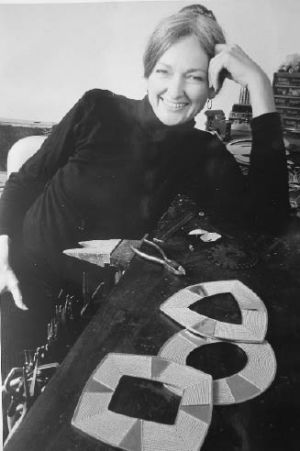By the time Mary Lee Hu was 6 years old, she knew she wanted to be an artist. She just didn’t know what kind.
And with the preponderance of painting, drawing and other standard art education opportunities in her hometown of Olmsted Falls, Ohio, metalwork didn’t at first occur to her, much less of the decorative variety.
“I was a tomboy,” she said. “It wasn’t jewelry that started me. I fell in love with working with the tools and the process and the materials more than jewelry itself.”
Hu loved the atmosphere of her father’s basement workshop and liked nothing better than to sit at his bench tinkering among the tools. But it wasn’t until she attended a music and art summer camp during high school that a teacher introduced her to a new set of implements, ones that could help her fashion wires and sheets into links, and in turn make those links into something functional, beautiful and wearable.
“Well, ma,” she said when she returned, “I want to be a metalsmith.”
While plenty of artists are self-taught in their chosen mediums, education factored strongly in the development of Hu’s career; later, she became a teacher as well as a creator, a profession she retired from in 2006.
One of the distinguishing characteristics of “Twenty-First Century Jewelry,” the show she’s recently curated at Bainbridge Arts and Crafts and that’s on display through April, is that it showcases work by herself and nine of her former students from the University of Washington.
Once metalwork clicked for Hu, she undertook years of continued study, including weekend and summer courses in high school, a bachelor of fine arts at Cranbrook Academy of Art outside Detroit, Mich., and a graduate degree from Southern Illinois University.
In college, she focused primarily on holloware, those pieces like bowls and tureens that while practical, nonetheless leave ample room for expansive creativity and endless discovery.
“I couldn’t believe that with a hammer, I could make a flat sheet into a vessel,” she said.
Jewelry took hold in a roundabout fashion during her second year of graduate school in 1966, when she signed on for an elective course in weaving and had to do an off-loom project at the end of the semester.
Her form was macrame – she likes to say “in my defense” that it was 1966, when macrame was new and hadn’t yet become a symbolic hippie cliché. Her medium was wire. And her instructor was excited, because the combination was entirely fresh.
“I was a graduate student,” she said. “I was supposed to do something new.”
The fabrication method Hu hit on in grad school and has continued to develop over the ensuing decades was modeled on a basketry process used by Native American tribes of the Northwest Coast called twining.
Holding her work in her lap just as traditional basket makers do, Hu uses wire to create the stiff warp form, and then twines the two wefts, or woven pieces, around each other as she moves them through the warp.
Weaving tightly and loosening later as needed, the method allows her to experiment with endless varieties of intricate, mesh-like patterns yet generate a reliably dense, off-perpendicular effect.
The final pieces, including her favored torque form, are springy enough to open up and put on, but stiff enough to keep their form.
Hu’s work struck a chord and gained national and international recognition. Pieces eventually were placed in the permanent collections of New York City’s Metropolitan Museum of Art and in London’s Victoria and Albert Museum.
It hasn’t escaped Hu’s notice that despite her early tomboyish tendencies, her work bears a deep cultural stamp of femininity, especially being so strongly informed by textiles and by the traditionally women’s craft of basket weaving.
And while she loved her students and enjoyed teaching enough to do it for roughly three decades, the gender politics got to her.
“It just seems like most of my career, I’ve been battling against most males who are in academe who say it’s not important – it’s just jewelry,” she said.
So on the one hand, major museums in New York, Boston and Houston have recently debuted major permanent jewelry collections and brought full-time jewelry curators on staff, and studio jewelry has become increasingly popular with collectors. On the other, the University of Washington saw fit not to replace Hu when she retired as head of the jewelry program last year. The fibers program was cut as well.
Instead, based she believes on media sensation and big funding, a glass program will be introduced. Which is fine, just not at other programs’ expense.
That’s one of Hu’s primary motivations for putting together this month’s show at BAC: to demonstrate that jewelry makers deserve to have their work studied and recognized, inside the academy and out.
“This is what was going on,” she said. “This is what the state is losing.”


